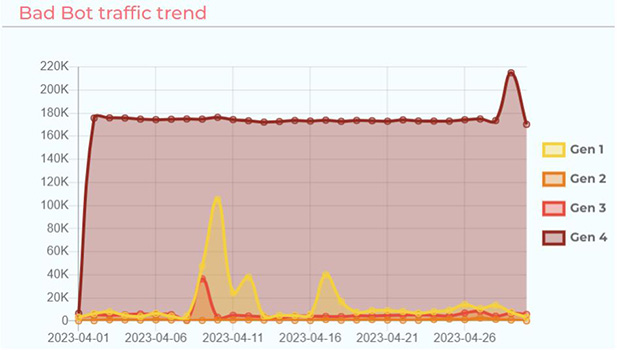 Bot detection is the process of analyzing all the traffic to a website, mobile application, or API, in order to detect and block malicious bots, while allowing access to legitimate visitors and authorized partner bots.
Bot detection is the process of analyzing all the traffic to a website, mobile application, or API, in order to detect and block malicious bots, while allowing access to legitimate visitors and authorized partner bots.
Bot detection is the process of identifying and distinguishing between human users and automated bots on websites, applications, or digital platforms. Bots are software programs that can perform tasks automatically, often with malicious or unwanted intentions. Bot detection aims to protect systems from the negative impacts of bot activity, such as fraudulent transactions, data scraping, account takeovers, or website spamming. It involves deploying various techniques and tools, such as user behavior analysis, IP analysis, machine learning algorithms, CAPTCHA challenges, and device fingerprinting, to accurately identify and differentiate between human users and bots. Effective bot detection helps maintain the integrity, security, and performance of online platforms by mitigating the risks associated with bot-driven activities.
How to Detect Bots: Bot Detection Techniques
User behavior analysis
Analyze user behavior patterns, such as mouse movements, keystrokes, and page navigation, to detect anomalies that may indicate bot activity.
IP analysis
Examine the IP addresses associated with user interactions to identify suspicious or known bot IPs. This can involve blacklisting or using IP reputation databases.
Human interaction challenges
Introduce interactive challenges, such as asking users to solve puzzles or provide context-based responses, that require human understanding and problem-solving skills to deter bots.
Device fingerprinting
Create unique device fingerprints based on factors like browser settings, installed plugins, screen resolution, and operating system to distinguish between human users and bots.
Machine learning algorithms
Utilize machine learning models to analyze large datasets and identify patterns and features that differentiate bots from human users. These models can be trained using labeled data to improve accuracy.
Bot signature detection
Maintain a database of known bot signatures, such as specific user agents or HTTP headers, and compare incoming requests against these signatures to flag potential bot activity.
Time-based analysis
Monitor the time taken to complete certain actions or interactions on a website or application. Unusually fast completion times may indicate automated bot activity.
Behavior-based heuristics
Define a set of rules and heuristics that capture common bot behavior, such as rapid form completion or high-frequency requests, and use these rules to detect potential bots.
Traffic analysis
Analyze patterns and characteristics of incoming traffic, such as unusual spikes in requests or a high percentage of traffic coming from a single source, to identify bot-generated traffic.
CAPTCHA challenges
Implement CAPTCHA (Completely Automated Public Turing test to tell Computers and Humans Apart) to verify whether a user is human by presenting them with a challenge that bots typically struggle to solve.
These techniques are not foolproof, and sophisticated bots may be designed to mimic human behavior or bypass certain detection methods. Therefore, a combination of multiple techniques and continuous monitoring through a dedicated bot management solution is necessary to effectively detect and mitigate bot activity.
Bot Detection Tools
Obsolete methods of blocking bots:
- Rule-based measures: Block IP ranges, countries, and data centers associated with bot activity.
- Web Application Firewalls (WAF) and Access Control Lists (ACL): Used to detect and block bad bots but less effective against advanced bots.
In-house bot detection measures:
- Initially deployed by some organizations but have disadvantages compared to specialized solutions.
- Ineffective in detecting advanced bad bots.
Specialized bot management solution like Radware Bot Manager:
- Combine cutting-edge technology and robust algorithms for bot detection.
- Utilizes methodologies including:
- Unique device fingerprinting: Create unique device identifiers to differentiate bots from humans.
- Dynamic Turing tests: Implement challenges that adapt based on bot behavior to identify them.
- User behavior analysis: Analyze patterns in user behavior to detect bot activity.
- JavaScript challenges: Present challenges that require JavaScript execution to filter out bots.
- Machine learning (ML) in detection engine:
- Trains algorithms based on known patterns and historical data.
- Detects new types of bots using ML techniques.
- Patented semi-supervised ML techniques detect malicious activities even without definitive bot signatures.
JavaScript Bot Detection
Radware Bot Manager's API call and embedded JavaScript tag collect and share several parameters about the visitor for processing by bot detection engine. Bot Manager’s detection engine works in real time to analyze every visitor to a website, mobile application, and API, and develops a unique fingerprint for each visitor and bot.
If a visitor is a human or search engine or partner bot, Bot Manager allows access in a few milliseconds—without slowing down the user experience. However, when a bad bot is detected, Bot Manager can block it, show a CAPTCHA, feed it with fake data, and utilize other types of responses based on an organization’s needs.
Five Benefits of Integrating Bot Management with Your CDN
Essentials of a Bot Detection Solution
A bot detection and management solution should detect and manage every kind of bot ─ good as well as bad ─ based on an organization’s specific needs. It should work in real-time to identify bot traffic and take measures such as blocking, showing a CAPTCHA to solve, feeding it with fake data, or dropping the connection, among other measures. Bot management tools should also be able to easily integrate with a wide range of Web and application infrastructure architectures to suit the unique needs of their users.